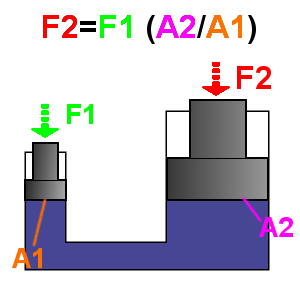Hydraulic press
Hydraulic Press
A hydraulic press is a machine press that uses a hydraulic cylinder to generate a compressive force. This type of press operates based on Pascal's principle, where the pressure throughout a closed system is constant. In a hydraulic press, this principle is used to amplify a small force applied to a small area into a larger force over a larger area, allowing for various industrial, manufacturing, and scientific applications.
History[edit | edit source]
The concept of the hydraulic press is based on principles of fluid mechanics that were first discovered and articulated by Blaise Pascal, a French mathematician, physicist, and inventor. The development of the hydraulic press is attributed to Joseph Bramah, an English inventor and locksmith, who patented the technology in 1795. Bramah's invention was initially intended for use in pressing and shaping leather, but its potential for other applications was quickly realized.
Design and Operation[edit | edit source]
The basic components of a hydraulic press include a hydraulic cylinder, a piston, and a hydraulic pump. The hydraulic pump provides a flow of hydraulic fluid to the cylinder, which moves the piston. The piston then exerts a force on the material being pressed. The force exerted by the piston is proportional to the hydraulic pressure and the piston area, allowing the hydraulic press to generate significant forces.
Types of Hydraulic Presses[edit | edit source]
There are several types of hydraulic presses, each designed for specific applications. These include:
- C-Frame Presses: Named for their C-shaped frame, these presses are used for applications requiring accessibility to the work area from three sides.
- H-Frame Presses: These presses have an H-shaped frame and are known for their strength and versatility, making them suitable for a wide range of applications.
- Four-Column Presses: These presses offer excellent rigidity and precision, with four columns supporting the moving platen.
Applications[edit | edit source]
Hydraulic presses are used in a wide range of applications, including:
- Metal forming: Including bending, stamping, and forging of metal parts.
- Molding: Used in the compression molding of plastics, composites, and other materials.
- Laminating: Applying pressure and heat to bond layers of materials together.
- Extraction: Extracting oils from seeds or juice from fruits through compression.
Safety and Maintenance[edit | edit source]
Safety is a critical consideration in the operation of hydraulic presses. Operators must be trained to use the press safely and to recognize the signs of wear and potential failure in the press's components. Regular maintenance is also essential to ensure the press operates efficiently and safely, including checking hydraulic fluid levels, inspecting hoses and connections for leaks, and ensuring that safety guards and devices are in place and functional.
Conclusion[edit | edit source]
The hydraulic press remains a vital tool in modern manufacturing, engineering, and research, thanks to its versatility, power, and efficiency. Its ability to apply significant force with precision makes it indispensable in many industrial processes.
Search WikiMD
Ad.Tired of being Overweight? Try W8MD's physician weight loss program.
Semaglutide (Ozempic / Wegovy and Tirzepatide (Mounjaro / Zepbound) available.
Advertise on WikiMD
|
WikiMD's Wellness Encyclopedia |
| Let Food Be Thy Medicine Medicine Thy Food - Hippocrates |
Translate this page: - East Asian
中文,
日本,
한국어,
South Asian
हिन्दी,
தமிழ்,
తెలుగు,
Urdu,
ಕನ್ನಡ,
Southeast Asian
Indonesian,
Vietnamese,
Thai,
မြန်မာဘာသာ,
বাংলা
European
español,
Deutsch,
français,
Greek,
português do Brasil,
polski,
română,
русский,
Nederlands,
norsk,
svenska,
suomi,
Italian
Middle Eastern & African
عربى,
Turkish,
Persian,
Hebrew,
Afrikaans,
isiZulu,
Kiswahili,
Other
Bulgarian,
Hungarian,
Czech,
Swedish,
മലയാളം,
मराठी,
ਪੰਜਾਬੀ,
ગુજરાતી,
Portuguese,
Ukrainian
Medical Disclaimer: WikiMD is not a substitute for professional medical advice. The information on WikiMD is provided as an information resource only, may be incorrect, outdated or misleading, and is not to be used or relied on for any diagnostic or treatment purposes. Please consult your health care provider before making any healthcare decisions or for guidance about a specific medical condition. WikiMD expressly disclaims responsibility, and shall have no liability, for any damages, loss, injury, or liability whatsoever suffered as a result of your reliance on the information contained in this site. By visiting this site you agree to the foregoing terms and conditions, which may from time to time be changed or supplemented by WikiMD. If you do not agree to the foregoing terms and conditions, you should not enter or use this site. See full disclaimer.
Credits:Most images are courtesy of Wikimedia commons, and templates, categories Wikipedia, licensed under CC BY SA or similar.
Contributors: Prab R. Tumpati, MD


